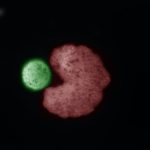
Background: John von Neumann came up with the idea of self-replicating machines in 1949. This lead to the computer virus…
Then in 1986 K. Eric Drexler coined the term Grey Goo. Read this carefully because it is very, very scary, and nobody will see it coming:
Imagine such a replicator floating in a bottle of chemicals, making copies of itself…the first replicator assembles a copy in one thousand seconds, the two replicators then build two more in the next thousand seconds, the four build another four, and the eight build another eight. At the end of ten hours, there are not thirty-six new replicators, but over 68 billion. In less than a day, they would weigh a ton; in less than two days, they would outweigh the Earth; in another four hours, they would exceed the mass of the Sun and all the planets combined — if the bottle of chemicals hadn’t run dry long before.
A progamming error or errant scientist is all that it takes. Of course this is all fantasy until someone actually invents it.
Err…
…these computer-designed and hand-assembled organisms can swim out into their tiny dish, find single cells, gather hundreds of them together, and assemble “baby” Xenobots inside their Pac-Man-shaped “mouth”—that, a few days later, become new Xenobots that look and move just like themselves.
And then these new Xenobots can go out, find cells, and build copies of themselves. Again and again.
“With the right design—they will spontaneously self-replicate,”
Team builds first living robots—that can reproduce [Harvard]
Many scientists don’t mind dabbling with danger, like creating black holes in labs. In this instance, the seem to not care that nothing is ever 100% safe:
These millimeter-sized living machines, entirely contained in a laboratory, easily extinguished, and vetted by federal, state and institutional ethics experts
It’s OK, they are only little…
This was not widely reported, and we are edging closer to a situation where dabbling with nature and assigning ourselves god-like powers could end all intelligent life as we know it.
